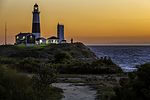Long Island is a densely populated island in southeastern New York State, constituting a significant share of the New York metropolitan area in terms of both population and land area. With over eight million inhabitants as of 2020, it is the most populous island in the United States and the 18th-most populous island in the world. The island extends from New York Harbor 118 miles (190 km) eastward into the North Atlantic Ocean with a maximum north–south width of 23 miles (37 km). With a land area of 1,401 square miles (3,630 km2), it is the largest island in the contiguous United States.Long Island is divided among four counties, with Kings (Brooklyn), Queens, and Nassau occupying its western third and Suffolk its eastern two-thirds. As of 2020, more than half (58.4%) of New York City residents live on Long Island in the boroughs of Brooklyn and Queens, although in common parlance, the term "Long Island", locally "the Island", refers exclusively to the counties of Nassau and Suffolk. Conversely, locally, the term "the City" refers to Manhattan alone. The Nassau–Suffolk-only definition of Long Island is recognized as a region by the State of New York. Although geographically an island, the Supreme Court of the United States has held that given the island's extensive ties to the mainland, it should be treated as a peninsula, giving the state jurisdiction over its maritime boundaries.Long Island may refer both to the main island and the surrounding outer barrier islands. To its west, Long Island is separated from Manhattan and the Bronx by the East River tidal estuary. North of the island is Long Island Sound, across which lie Westchester County, New York, and the state of Connecticut. Across the Block Island Sound to the northeast is the state of Rhode Island. Block Island—which is part of Rhode Island—and numerous smaller islands extend farther into the Atlantic. To the extreme southwest, Long Island, at Brooklyn, is separated from Staten Island and the state of New Jersey by Upper New York Bay, the Narrows, and Lower New York Bay.
With a population of 8,063,232 residents as of the 2020 U.S. census, constituting 40% of the State of New York's population, Long Island is the most populated island in any U.S. state or territory, the third-most populous island in the Americas (after only Hispaniola and Cuba), and the 18th-most populous island in the world (ahead of Ireland, Jamaica, and Hokkaidō). Its population density is 5,859.5 inhabitants per square mile (2,262.4/km2). If Long Island geographically constituted an independent metropolitan statistical area, it would rank fourth most populous in the United States; if it were a U.S. state, Long Island would rank thirteenth in population and first in population density. Long Island is culturally and ethnically diverse, featuring some of the wealthiest and most expensive neighborhoods in the world near the shorelines, as well as working-class areas in all four counties.
As of 2022, Kings, Queens, Nassau, and Suffolk counties collectively had a gross domestic product of approximately US$418 billion. Median household income on the island significantly exceeds $100,000, and the median home price is approximately $600,000, with Nassau County approximating $700,000. Among residents over the age of 25, 42.6% hold a college degree or higher educationally. Unemployment on Long Island stays consistently below 4%.
As a hub of commercial aviation, Long Island is home to two of the nation's and New York City metropolitan area's three busiest airports, JFK International Airport and LaGuardia Airport, in addition to Long Island MacArthur Airport; as well as two major air traffic control radar facilities, the New York TRACON and the New York ARTCC. Nine bridges and thirteen navigable tunnels (road and railroad tunnels but not metropolitan water tunnels) connect Brooklyn and Queens to the three other boroughs of New York City. Ferries connect Suffolk County northward across Long Island Sound to Connecticut. The Long Island Rail Road is the busiest commuter railroad in North America and operates continuously. Biotechnology companies, engineering, and scientific research play a significant role in Long Island's economy, including research facilities at Brookhaven National Laboratory, Cold Spring Harbor Laboratory, Stony Brook University, New York Institute of Technology, Plum Island Animal Disease Center, the New York University Tandon School of Engineering, the Zucker School of Medicine, and the Feinstein Institutes for Medical Research.







